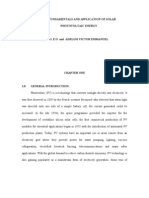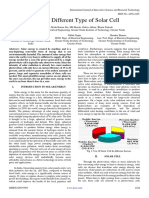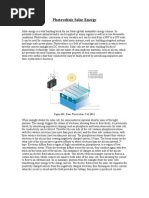Photovoltaics: An Initiative Step Towards Sustainable Technology
Photovoltaics: An Initiative Step Towards Sustainable Technology
Copyright:
Available Formats
Photovoltaics: An Initiative Step Towards Sustainable Technology
Photovoltaics: An Initiative Step Towards Sustainable Technology
Original Title
Copyright
Available Formats
Share this document
Did you find this document useful?
Is this content inappropriate?
Copyright:
Available Formats
Photovoltaics: An Initiative Step Towards Sustainable Technology
Photovoltaics: An Initiative Step Towards Sustainable Technology
Copyright:
Available Formats
IOSR Journal of Electrical and Electronics Engineering (IOSR-JEEE) e-ISSN: 2278-1676 Volume 4, Issue 4 (Jan. - Feb.
2013), PP 19-23 www.iosrjournals.org
Photovoltaics: An Initiative Step towards Sustainable Technology
Ayesha Tooba Khan
(Department of Electrical Engineering , Zakir Husain College of Engineering & Technology, Aligarh Muslim University, India)
Abstract : The energy crisis is appearing as a grave problem the whole world is facing today. The challenge is to refine the renewable technologies to make them competitive with traditional energy sources. The paper mainly focuses on the recent trends in Photovoltaic Technology and photovoltaic market development in brief. Recent trends adopted in photovoltaics offers a key solution to deliver a sustainable, secure, reliable and long term supply of energy at efficient rate and affordable cost to the livelihood. The fast growing photovoltaic technology has currently acquired a position to lead the worldwide challenge and also has boosted the opportunities in industrial sector. The remarkable growth of the photovoltaic sector in recent years provides a clear justification for this publication. Also, the paper will give insight to the basics of photovoltaics. Keywords - Cost and Performance, Energy Demand, Photovoltaic Technology, Renewable Energy Resources, Sustainable Development. I.
INTRODUCTION
The growing demand of energy and unjustified usage of traditional energy resources has led to a devastating imbalance in natural environment. The demand for energy is growing day by day but the corresponding supply is not rising with the same pace. Thus, energy crisis has become a key issue which must be addressed at extreme priority. The problem is not just to fulfil the present energy demands but also to establish a clean, safe, robust and efficient system for sustainable growth and development around the world. After exploration of various renewable energy resources like wind, hydroelectric, biomass and geothermal, a straight and right path has come into picture where the sun never sets. On average, the Earth receives about 12 MW of solar power. The challenge is to trap even a tiny fraction of this energy for sustainable future. The average annual growth rate of Global PV technology capacity is more than 40% since 2000 and it is expected to have significant potential for long term growth over the next decades. It is estimated that PV technology will provide 11% of global electricity production which is equal to 4500 TWh per year corresponding to 3000 GW of cumulative installed PV capacity and will avoid 2.3 gigatonnes of CO 2 emissions per year [1]. Photovoltaics is becoming increasingly inexpensive which is making PV sector more lucrative. In the recent market, solar PV systems are more than 60% cheaper than they were in the 1990s [2]. Looking at these aspects of photovoltaics, even the developing nations have taken the initiatives and are investing more in PV sector. The target is not just to install PV systems but also to reduce the manufacturing & installation cost to make them profitable. The paper will review some of the advancements in technology which are most important in accounting for cost reduction and encouraging the performance of solar installations around the world and the position acquired by PV technology in global market.
II.
PHOTOVOLTAIC TECHNOLOGY
2.1. Introduction Photovoltaics is the field of technology and research which directly converts solar energy into electrical energy using the devices that exhibits Photovoltaic Effect. In 1950s, the technology was developed for the space program to power the satellites. Later, in the early 1970s, it reached to a commercial status due to the evolving energy crisis. Semiconductor device called a solar cell can be considered as the heart of solar PV technology. The output power of the solar cell depends on the intensity of the incident radiation, its design and materials, and its temperature. Individual solar cells are electrically connected to each other and mounted in a frame which is called a PV module or panels. Several modules are wired together to make an array. They may either be connected in series or parallel to provide desirable voltage and current levels. 2.2. Photovoltaic cell types The basic types of solar cells are wafer-based silicon cells and thin film solar cells. Wafer-based silicon cells are either cut from a single crystal rod or from a block made up of many crystals and accordingly called as mono-crystalline or multi-crystalline silicon solar cells. Wafer-based silicon cells are around 200 micron thick while thin film solar cells are approximately 1-2 micron thick and therefore less manufacturing cost is required in production of these cells. However, thin films indicate lower efficiencies than wafer-based silicon solar cells www.iosrjournals.org 19 | Page
Photovoltaics: An Initiative Step towards Sustainable Technology
in the real world which means that more surface area and material is required for the installation to get a similar performance. Thus, Crystalline silicon has maintained at least 80% of the worldwide market production for nearly past 30 years [3]. 2.3. PV Technologies There are two principal types of PV collection systems namely, Flat-plate and Concentrating. Flat-plate PV arrays can be mounted in a fixed orientation or allowed to track the movement of the sun. They respond to direct or diffuse sunlight. Concentrating PV systems employ less expensive materials such as lenses or mirrors to capture the incident solar radiations. Such systems usually employ at least 100 times concentration. But these concentrators cant focus diffuse light which is about 30% of the solar radiation on a clear day. Moreover, due to high concentration of solar radiations, the temperature of the system rises and hence cell efficiencies and system stability is affected. For these reasons, Concentrating PV systems still account for less than 1% of the PV market[3].
III.
TECHNOLOGY STATUS AND TRENDS
Major trends in PV technology mainly focus on improving performance as well as lowering manufacturing costs. After having mono crystalline, poly crystalline, amorphous thin-film and multi-junction cells, various innovative ideas have been evolved in recent years to make the technology more advanced. 3.1. Nanostructure solar cell Princeton University researchers, led by an electrical engineer Stephen Chou, have found a simple and economic way to increase the efficiency of organic solar cells by 175 per cent. It is expected that this technology also would increase the efficiency of conventional inorganic solar cells, although the research is still in progress with inorganic devices. Their work has been published in the journal Optical Material Express Nov 2, 2012[4]. The device uses a nanostructured sandwich of metal and plastic which collect s and traps light. The sandwich called Subwavelength Plasmonic Cavity, has extraordinary ability to trap the incident light and hence reduces the possibility of reflection. These cells reflects only about 4% of incident solar radiations. Using these devices, 52% higher efficiency is achieved in converting light energy into electrical energy than a conventional solar cell. Fig.1 shown below depicts the trapping of radiations in conventional solar cell and advanced solar cell.
Figure 1:Trapping of light in Conventional Solar Cell and PlaCSH Solar Cell The efficiency boosts to 81% when light strikes the cells at larger angle on cloudy days resulting to 175% of total increase. In place of Indium Tin Oxide (ITO), the most expensive part of conventional solar cells, the top layer uses a 30 nm thick mesh which is made up of metal, having apertures 172 nm in diameter and spacing 25 nm apart. This mesh is placed close to bottom layer of the same metal film used in conventional solar cells. A thin strip of semiconducting materials like silicon or Gallium arsenide (GaAs) is placed between the two metal sheets. The key features of the cell are the spacing of the mesh, the thickness of the sandwich, and the diameter of the holes which are all smaller than the wavelength of incident light. These subwavelength structures traps the light with almost no reflection. It is like a black hole for light , said Chou[4]. The system has been given the name Plasmonic Cavity with Subwavelength Hole Array (PlaCSH) and it can be manufactured in wallpaper sized sheets using a process called Nanoimprints. PlaCSH is extremely bendable while conventional solar cells are rigid. Apart from the higher efficiency, it can reduce the manufacturing cost and make the panels more flexible as it uses extremely thin layer of semiconducting material. The team plans further experiments and expects to increase the efficiency of the PlaCSH system as they refine the technology, Chou said[4]. www.iosrjournals.org 20 | Page
Photovoltaics: An Initiative Step towards Sustainable Technology
3.2.All Carbon Solar Cell Stanford University Researchers, led by Zhenan Bao, professor at Stanford, have developed a solar cell made entirely of Carbon which is considering as an alternative to the expensive materials used in PV devices. For example, ITO used in conventional solar cell is more expensive because of its high demand in PV market and scarcity of Indium while Carbon is a low cost abundant material. The flexible Carbon solar cell consists of a photoactive layer, sandwiched between the two electrodes. The ITO and Silver used in conventional electrodes is replaced with graphene, 1 atom thick Carbon sheet and single-walled Carbon nanotubes which are 10,000 times narrower than a human hair. These carbon nanotubes have extraordinary light absorbing tendency and electrical conductivity and they can be dispersed in water or organic solvent with the help of surfactants thereby can be used in coating processes which is a low cost manufacturing technique. "Perhaps in the future we can look at alternative markets where flexible carbon solar cells are coated on the surface of buildings, on windows or on cars to generate electricity " Bao said[5]. The active layer is made up of carbon nanotubes, acting as donor layer and bucky balls, soccer ball shaped carbon molecules which are 1nm in diameter and serves as electron acceptor. The device can perform under extreme conditions as it consists of carbon materials which have excellent mechanical properties and they remain stable at the temperature around 1,100 degrees Fahrenheit. These Carbon cells primarily absorb near infrared wavelengths of light which effects the efficiency of the cell and it appears as the drawback for this low cost & robust technique. Looking at the ability of the device to perform under extreme conditions, a compromise can be made with the efficiency. Although, the Stanford Team is performing experiments with carbon nano materials to improve efficiency so that it can absorb more light in a broader range of wavelengths[5]. 3.3. Colloidal Quantum Dot Solar Cell A team of researchers from University of Toronto (U & T), Canada and King Abdullah University of Science & Technology (KAUST),Saudi Arabia , under the supervision of professor Ted Sargent of U & T have introduced the most efficient Colloidal Quantum Dot (CQD) solar cell. Their work has been published in Nature Materials[6]. Quantum dots are basically the semiconducting materials whose size is of the order of nanometre and are compatible to spray on to flexible surfaces. The energy gap of CQDs can be varied over a wide range of energies just by modifying their size which enables them to absorb light from visible as well as invisible region of the entire spectrum. This technique has low manufacturing cost, greater durability and can be created quickly as compared to conventional solar cells. Earlier, the work was carried out with organic molecules which resulted in high surface area to volume ratio thereby affecting the cell efficiency by creating the traps for electrons and providing them with the recombination time. But, now it has been replaced with inorganic ligands to bind the quantum dots together with less space between them and to limit the number of traps for electrons thereby improving surface quality. "By introducing small chlorine atoms immediately after synthesizing the dots, we're able to patch the previously unreachable nooks and crannies that lead to electron traps ," said Alex, lead coauthor[6]. With this close packing combination and charge trap elimination, the device has been modified to provide a world-record efficiency of 7.0 %. Researches are still going on for further reducing the electron traps and introducing different size of quantum dots to make the cell highly efficient. A technology licensing agreement has been signed by KAUST and U&T to make the use of technology popular on commercial scale. "Our world urgently needs innovative, cost-effective ways to convert the sun's abundant energy into usable electricity. This work shows that the abundant materials interfaces inside colloidal quantum dots can be mastered in a robust manner, proving that low cost and steadily-improving efficiencies can be combined." Said Professor Sargent[6].
IV.
PHOTOVOLTAIC MARKET DEVELOPMENT
As a result of improving power conversion efficiencies, development of low cost solar fabrication processes and huge increase in cell production volume, significant cost reductions are expected to continue which will help the PV market development. Currently, photovoltaics has become the third most important renewable energy source in terms of globally installed capacity after hydro and wind power [7]. 4.1. Photovoltaics Growth around the World From the Fig. shown below, it can be clearly seen that the growth of PV sector is remarkable from 2009-2012. The annual installed amount of PV system is expressed in GW and is represented by the bars shown in Fig. The approximate growth rate was around 70% per year during the session 2007-2012. There was a heavy blow of 172% in PV market during 2009 and 2010. At the end of 2011, there was a total of about 62 GW of installed PV systems around the globe. However, in 2011 the growth was just satisfactory. With increasing interest in energy market, PV technology is growing at a rapid rate around the whole world. www.iosrjournals.org 21 | Page
Photovoltaics: An Initiative Step towards Sustainable Technology
Figure2: PV Solar Growth in GW[8] 4.2. PV Installations in various Nations The Table below shows that Germany is currently leading the global PV market and by the year 2020, Germany has set the aim to replace all its nuclear power by renewable energy resources. The year 2011 was the blooming year for Italy as there was the whopping growth of PV installations in the country[8]. It is estimated that 40% of the projects bought are located in Germany while 35% are in Italy and the remaining 25% are located internationally. Apart from the well developed nations like Germany, Italy, United States, France, Japan and Australia, even the developing nations like India and China are investing more in PV sector for sustainable growth and development. China produces more than half the worlds supply of solar modules so it is obvious that government of China will also focus on local installations. In India, Jawahar Lal Nehru National Solar Mission is targeting 20 GW of generation capacity by 2022[9]. In an article written by Raj Prabhu in Mercom Capital Group, it is claimed that Gujarat state has completed with 655 MW of its 968.5 MW goal [9]. States like Karnataka, Orissa and Tamil Nadu are also accounting for PV installations to boost solar power production in India. Table 1: PV Solar Installations By Country[8]
Country Germany Italy United States Japan France China Australia India ROTW Total Market 2010 7.5 4.3 0.9 0.9 0.6 0.6 0.4 0.1 4.3 19.6 2011 7.5 6.3 1.9 1.3 1.8 2.8 0.8 0.6 4.3 27.3 2012 5.5 4.5 3.8 2.5 1.5 4.5 1.0 1.5 5.1 29.9
V.
CONCLUSION
Worldwide PV system installation has been growing at a rapid rate in past few years. A key goal is to drive down the cost of production by introducing extraordinary advancements in PV technology which can make Photovoltaics more delicious. And no doubt, we have taken the initiative towards the destiny. The paper has reviewed the latest technologies that should be adopted on commercial scale very soon to boost the solar power production as we are surrounded with issues like Global Warming and Energy Crisis. Photovoltaic sector can be made more productive & competitive with these stronger efforts & technological innovations. The current status of PV sector in various countries has been discussed in brief which can give an approximate idea about the development and economic status of the countries. Though, it is uncertain to predict the extent of future growth of this dynamic and fast growing technology just by looking at the current status it is expected that advanced PV technology will provide the path to go green with sustainability and affordability.
www.iosrjournals.org
22 | Page
Photovoltaics: An Initiative Step towards Sustainable Technology REFERENCES
[1] [2] [3] [4] [5] [6] [7] [8] [9] Technology Roadmap- Solar Photovoltaic Energy,IEA Report, Photovoltaic Solar Energy Development and current research , European Commission 2009 Solar Photovoltaics: Status, Costs and Trends, EPRI, December 2009 Princeton University, Engineering School.Tiny Structure Gives Big Boost to Solar Power. Science Daily, 6Dec..2012. Web.13Dec.2012 Scientists Build the First All-Carbon Solar Cell. Science Daily, Stanford University.31Oct.2012. Web.12 Jan.2013 University of Toronto Faculty of Applied Science & Engineering . Record efficiency for next-generation solar cells. ScienceDaily. 29Jul.2012. Web 31Dec.2012 Photovoltiacs- wikipedia, [accessed 16Dec. 2012] Raj Prabhu,Will india join the gigawatt club this year?, Mercom Capital Group,[www.mercom capital.com/india-newsanalysis][accessed 02Jan.2013] Solar cell central By: Four Peak technologies, Inc. Scottsdale, AZ, Solar Markets [solar cell central.com/markets_page.html],[accessed 16Jan.2013]
www.iosrjournals.org
23 | Page
You might also like
- Untitled - NotepadDocument34 pagesUntitled - NotepadSai Gokul KNo ratings yet
- Solar Panel Out of CD Disk and DiodeDocument11 pagesSolar Panel Out of CD Disk and DiodeJoseph Pendon83% (6)
- Eawm Eastern Europe PDFDocument1,100 pagesEawm Eastern Europe PDFv0% (1)
- Nanomaterials For Solar Energy Conversion and ApplicationsDocument10 pagesNanomaterials For Solar Energy Conversion and Applicationsup4all100% (1)
- Seminar Report 2Document23 pagesSeminar Report 2Mayank S.H88% (8)
- 2013 49 Winter Wiring Matters Solar EnergyDocument4 pages2013 49 Winter Wiring Matters Solar EnergyDebajyoti GhoshNo ratings yet
- Reniel F. Fabro Bsee-IvDocument17 pagesReniel F. Fabro Bsee-Ivreniel fabroNo ratings yet
- Solar PV Individual ReportDocument7 pagesSolar PV Individual ReportshathishNo ratings yet
- Solar Cell Literature ReviewDocument6 pagesSolar Cell Literature Reviewaflsktofz100% (1)
- Solar Cells and Nanotechnology: Bharathidasan.D, Muhibullah.JDocument4 pagesSolar Cells and Nanotechnology: Bharathidasan.D, Muhibullah.JTanaji PatilNo ratings yet
- EME4353: Advanced Engineering Materials Assignment 1Document7 pagesEME4353: Advanced Engineering Materials Assignment 1Shakil MalikNo ratings yet
- Supervisor: Dr. Shah Alam Mentor: Dr.M.J.Siddiqui Presented By: Surbhi AgarwalDocument27 pagesSupervisor: Dr. Shah Alam Mentor: Dr.M.J.Siddiqui Presented By: Surbhi AgarwalMr. K.S. Raghul Asst Prof MECHNo ratings yet
- Report of Infrared Plastic Solar CellDocument22 pagesReport of Infrared Plastic Solar CellMaster Shifu85% (54)
- Infrared Plastic Solar CellDocument28 pagesInfrared Plastic Solar CellChandra PrakashNo ratings yet
- IJSDR1902043Document8 pagesIJSDR1902043Boutaina BoujradaNo ratings yet
- Supervisor: Dr. Shah Alam Mentor: Dr.M.J.Siddiqui Presented By: Surbhi AgarwalDocument27 pagesSupervisor: Dr. Shah Alam Mentor: Dr.M.J.Siddiqui Presented By: Surbhi AgarwalMr. K.S. Raghul Asst Prof MECHNo ratings yet
- Seminar 2Document23 pagesSeminar 2Muhd Shabeeb ANo ratings yet
- Solarcells Using NanotechnologyDocument15 pagesSolarcells Using Nanotechnologyvenkatasrinivas45No ratings yet
- A Review Paper On Photovoltaic TextilesDocument13 pagesA Review Paper On Photovoltaic TextilesShradha Shinde DongreNo ratings yet
- Research Report 2Document7 pagesResearch Report 2kim.torongz13No ratings yet
- Renewable Sources of EnergyDocument12 pagesRenewable Sources of Energymicmech100% (1)
- Impact of Defects On Quality Contact Systems For Photoelectric ConvertersDocument5 pagesImpact of Defects On Quality Contact Systems For Photoelectric ConvertersСергей ХрипкоNo ratings yet
- UsmaanDocument5 pagesUsmaanAAKIB QURESHINo ratings yet
- EJMCM Volume 7 Issue 4 Pages 1389-1401Document13 pagesEJMCM Volume 7 Issue 4 Pages 1389-1401Gurucharan GNo ratings yet
- Final ReportDocument39 pagesFinal ReportmohdNo ratings yet
- Plastic Solar Cells Report Part 2Document32 pagesPlastic Solar Cells Report Part 2IRSHAD PNo ratings yet
- Organic Solar CellDocument24 pagesOrganic Solar CellSeptian Suryananda100% (1)
- Need For Solar CellsDocument36 pagesNeed For Solar CellssahitNo ratings yet
- Solar Energy Conversion Toward 1 TeraWattDocument19 pagesSolar Energy Conversion Toward 1 TeraWattMatias VilchesNo ratings yet
- Minor Project Report Solar CellsDocument8 pagesMinor Project Report Solar CellsDr. Rakesh SohalNo ratings yet
- Shathish Solar PVDocument7 pagesShathish Solar PVshathishNo ratings yet
- Vaagdevi College of EngineeringDocument20 pagesVaagdevi College of EngineeringAkhil GongalaNo ratings yet
- A Guide To Grid-Connected Photovoltaic SystemsDocument9 pagesA Guide To Grid-Connected Photovoltaic Systemsjobpei2No ratings yet
- INSTALL YOUR OWN Photovoltaic System: Hybrid, Stand Alone and Battery StorageFrom EverandINSTALL YOUR OWN Photovoltaic System: Hybrid, Stand Alone and Battery StorageNo ratings yet
- Solar Paner AbyDocument11 pagesSolar Paner AbyJOVAN HILMANSYAHNo ratings yet
- Solar Cell IntroductionDocument12 pagesSolar Cell Introductionmuhammad shahbazNo ratings yet
- Plastic Solar Cell Technology: Submitted To: - Submitted byDocument37 pagesPlastic Solar Cell Technology: Submitted To: - Submitted bynavya80% (5)
- Material Cells SolarsDocument45 pagesMaterial Cells SolarsMillagui VicenteNo ratings yet
- Elegant Method To Improve The Efficiency of Remotely Located SolarDocument11 pagesElegant Method To Improve The Efficiency of Remotely Located SolarhatomiNo ratings yet
- Flexible Solar Cells: Mario Pagliaro, Rosaria Ciriminna, and Giovanni PalmisanoDocument12 pagesFlexible Solar Cells: Mario Pagliaro, Rosaria Ciriminna, and Giovanni PalmisanoGokul VenugopalNo ratings yet
- R&DET Unit 3-1Document46 pagesR&DET Unit 3-1Uggina Narisinga RaoNo ratings yet
- R&DET Unit 3Document39 pagesR&DET Unit 3Uggina Narisinga RaoNo ratings yet
- Fundamentals and Application of Solar PhotovoltaicsDocument24 pagesFundamentals and Application of Solar PhotovoltaicsEmmanuel OgoloNo ratings yet
- 4 PVDocument52 pages4 PVkaramn3matNo ratings yet
- Circuit Diagram Explanation .: Project SummaryDocument15 pagesCircuit Diagram Explanation .: Project SummaryKanhaiya KumarNo ratings yet
- Study of Different Type of Solar CellDocument4 pagesStudy of Different Type of Solar CellInternational Journal of Innovative Science and Research TechnologyNo ratings yet
- Solar Cells - Thin-Film TechnologiesDocument468 pagesSolar Cells - Thin-Film Technologiesblores100% (1)
- Solar Cell CourseworkDocument5 pagesSolar Cell Courseworkbcqy65mx100% (2)
- Photo Voltaic Solar EnergyDocument6 pagesPhoto Voltaic Solar EnergyPhilip Donovan BradleyNo ratings yet
- Economics of Flexible Solar CellDocument5 pagesEconomics of Flexible Solar Cellaimenhafeezmalik68No ratings yet
- Solar Energy Harvesting: Innovations in Photovoltaic Materials (WWW, Kiu, Ac, Ug)Document5 pagesSolar Energy Harvesting: Innovations in Photovoltaic Materials (WWW, Kiu, Ac, Ug)publication1No ratings yet
- Design and Development-2546Document21 pagesDesign and Development-2546Kint PanenNo ratings yet
- Report Infrared Solar CellDocument22 pagesReport Infrared Solar Cellabhishek5singh5surajNo ratings yet
- Presentation ON Solar Cell and Advancement in TechnologyDocument20 pagesPresentation ON Solar Cell and Advancement in Technologyappy sagarNo ratings yet
- (Anwar, Sohail PDFDocument616 pages(Anwar, Sohail PDFZarrit RidaNo ratings yet
- Plastic Solar Cell, ArticleDocument2 pagesPlastic Solar Cell, ArticleAbhishek ModiNo ratings yet
- Significance of Solar InvertersDocument10 pagesSignificance of Solar Invertershedonist81No ratings yet
- A Review Paper On Development in MaterialDocument7 pagesA Review Paper On Development in MaterialRavindra PawarkarNo ratings yet
- Infrared Plastic Solar Cell, 478Document19 pagesInfrared Plastic Solar Cell, 478Princess ShonaNo ratings yet
- Solar Panel Cleaning SystemDocument11 pagesSolar Panel Cleaning SystemAkshay Hejjaji67% (3)
- 219-225Document7 pages219-225Nodirbek TopvoldiyevNo ratings yet
- Solar Panel Improvement: 1950–2016: For Solar, by Solar, to SolarFrom EverandSolar Panel Improvement: 1950–2016: For Solar, by Solar, to SolarNo ratings yet
- Effects of Formative Assessment On Mathematics Test Anxiety and Performance of Senior Secondary School Students in Jos, NigeriaDocument10 pagesEffects of Formative Assessment On Mathematics Test Anxiety and Performance of Senior Secondary School Students in Jos, NigeriaInternational Organization of Scientific Research (IOSR)100% (1)
- Necessary Evils of Private Tuition: A Case StudyDocument6 pagesNecessary Evils of Private Tuition: A Case StudyInternational Organization of Scientific Research (IOSR)No ratings yet
- Comparison of Explosive Strength Between Football and Volley Ball Players of Jamboni BlockDocument2 pagesComparison of Explosive Strength Between Football and Volley Ball Players of Jamboni BlockInternational Organization of Scientific Research (IOSR)No ratings yet
- Youth Entrepreneurship: Opportunities and Challenges in IndiaDocument5 pagesYouth Entrepreneurship: Opportunities and Challenges in IndiaInternational Organization of Scientific Research (IOSR)100% (1)
- Factors Affecting Success of Construction ProjectDocument10 pagesFactors Affecting Success of Construction ProjectInternational Organization of Scientific Research (IOSR)No ratings yet
- Design and Analysis of Ladder Frame Chassis Considering Support at Contact Region of Leaf Spring and Chassis FrameDocument9 pagesDesign and Analysis of Ladder Frame Chassis Considering Support at Contact Region of Leaf Spring and Chassis FrameInternational Organization of Scientific Research (IOSR)No ratings yet
- Fatigue Analysis of A Piston Ring by Using Finite Element AnalysisDocument4 pagesFatigue Analysis of A Piston Ring by Using Finite Element AnalysisInternational Organization of Scientific Research (IOSR)No ratings yet
- B 160 - 99 Qje2maDocument6 pagesB 160 - 99 Qje2mawahyudiNo ratings yet
- Soil-Structure Interaction: Effective Seismic Input MethodDocument22 pagesSoil-Structure Interaction: Effective Seismic Input Methodgurpinder.rajgarh1331No ratings yet
- Catalog - GLT Gate ValveDocument9 pagesCatalog - GLT Gate Valveyudii.hidayatNo ratings yet
- Ic 7408Document26 pagesIc 7408TfNo ratings yet
- 3PE - 0002 - en - Weigh ModulesDocument88 pages3PE - 0002 - en - Weigh ModulesVicente Martinez CruzNo ratings yet
- Automobile EngineeringDocument66 pagesAutomobile EngineeringŜṟéẻ Ṛąṁ Chowdary100% (1)
- Instructions AND Parts Manual Go-Fer Iii-Ox Go-Fer Iii-Pl Go-Fer Iii-WdDocument22 pagesInstructions AND Parts Manual Go-Fer Iii-Ox Go-Fer Iii-Pl Go-Fer Iii-Wdmilenko CortesNo ratings yet
- Flight Vehicle Design Aircraft DesignDocument18 pagesFlight Vehicle Design Aircraft DesignKarthikeya ReddyNo ratings yet
- Stephen Drum's Syllabus P280 Spring 2013Document4 pagesStephen Drum's Syllabus P280 Spring 2013RogueCmzNo ratings yet
- DBR of Warehoused Precast Wall Panel - R0Document8 pagesDBR of Warehoused Precast Wall Panel - R0Ganesh RasankarNo ratings yet
- Development and Verification of A Fully Adaptive Pushover ProcedureDocument10 pagesDevelopment and Verification of A Fully Adaptive Pushover ProcedureVicente BonoNo ratings yet
- SBD Upfdr 146Document122 pagesSBD Upfdr 146MANISH SINGHNo ratings yet
- Mössbauer EffectDocument13 pagesMössbauer EffectPrasad RavichandranNo ratings yet
- Curriculum Vitae Uzma Imran PDFDocument4 pagesCurriculum Vitae Uzma Imran PDFMJANo ratings yet
- (Bernoulli Principle K-4) Principles of FlightDocument38 pages(Bernoulli Principle K-4) Principles of Flightbb06412000No ratings yet
- Steris Generador de VaporDocument4 pagesSteris Generador de VaporANDRES MALDONADONo ratings yet
- Build A Simple PHP Application: Stage 3 Adding A Contact FormDocument4 pagesBuild A Simple PHP Application: Stage 3 Adding A Contact FormOmerAsadullahNo ratings yet
- SPE 52157 Selection of Artificial LiftDocument30 pagesSPE 52157 Selection of Artificial LiftORLANDO GONZALEZNo ratings yet
- Brake Removal and Installation Practical Guide To Master Cylinder RepairDocument13 pagesBrake Removal and Installation Practical Guide To Master Cylinder RepairFOROTNo ratings yet
- G-2140 / S-2140 Alloy Bolt Type Anchor ShacklesDocument1 pageG-2140 / S-2140 Alloy Bolt Type Anchor ShacklesCompact LiftingNo ratings yet
- AssemblyDocument45 pagesAssemblyKaan Zumrutkaya100% (1)
- Oslo Mihai Neacsu, IcpeDocument12 pagesOslo Mihai Neacsu, IcpeMihaiNeacsuNo ratings yet
- Project Name: E-Municipal CorporationDocument6 pagesProject Name: E-Municipal Corporationvikassingh1000No ratings yet
- 3 BHK House Plan 1Document1 page3 BHK House Plan 1dolar buhaNo ratings yet
- Issues and Work A Rounds For The Siebel DAC Compare and Merge StrategyDocument2 pagesIssues and Work A Rounds For The Siebel DAC Compare and Merge StrategyRajender DudduNo ratings yet
- 1N5400 THRU 1N5408: Reverse Voltage - 50 To 1000 Volts Forward Current - 3.0 AmperesDocument3 pages1N5400 THRU 1N5408: Reverse Voltage - 50 To 1000 Volts Forward Current - 3.0 AmperesAndres Jacob Sanchez JaraNo ratings yet
- b18834 - TT UGRD 2310Document22 pagesb18834 - TT UGRD 2310drsbg6v5dcNo ratings yet
- Sika® UCS Pak: Product Data SheetDocument3 pagesSika® UCS Pak: Product Data SheetKhoiNguyen1205No ratings yet
































































































